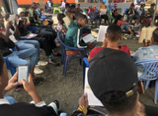Elementary Swahili: Lugha na Utamaduni
Faster downloadPublished Year: 2020

Language: multiple
Details: Creative Commons 4.0
Summary: Swahili or Kiswahili is a bantu language that is spoken in East Africa/Afrika Mashariki. It is both a national and official language in Kenya and Tanzania and is the official language of the East African Community member states which include: Kenya, Tanzania, Uganda, Rwanda, Burundi, and South Sudan. Swahili is spoken in other African countries such as Democratic Republic of Congo (DRC), Mozambique, and the Comoros Islands. It is also taught in Ghana, South Africa, Zimbabwe, and many countries outside Africa. In the U.S. Swahili is the leading sub-saharan African language that is taught in colleges and universities. Swahili is used as a language of instruction in Tanzania up to high school but taught as a subject at schools in other East African countries. The Swahili speakers have interacted with many speakers of other languages over a long period of time. For this reason, Swahili has borrowed words from some of these languages, especially Arabic. Swahili uses Roman alphabets and is written from left to right. However, there are certain English alphabets that do not exist in Swahili and there are a couple of Swahili alphabets that are not in English. Swahili is an agglutinative language and for that reason, a verb can be a sentence on its own because it may contain all the grammatical elements of a Swahili sentence. Further, Swahili is spoken the way it is written and written the way it is spoken.








